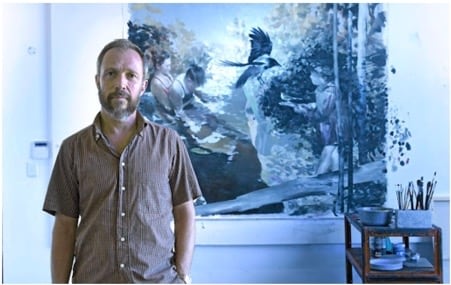
Mystery inside an enigma: All of Norwegian painter Lars Elling’s pictures have a narrative with an emotional texture that can send viewers right off their chumps with intrigue. Picture: JAC DE VILLIERS
Norwegian painter Lars Elling, who has already been heaped with international glory, has built a studio in SA where he spends the summers.
He is lithe, almost balletic in his movements. He appears well balanced, both physically and mentally, curious about the world and tolerant of other people’s foibles — everything that a Norwegian social democrat should be — and kind to boot.
He is married with three daughters and the youngest is only four-years-old.
His exterior reveals little of the paintings he executes which are filled with dark intelligence and the shadow of madness. One gets a sense of the beauty and savagery of the world simultaneously, something that seldom happens in real life.
Elling has the same facility with metaphors as Angela Carter’s fiction (I recall a pink corset sticking out of a coal scuttle) but less overwhelming, more controlled and never sentimental or sensational.
All the pictures have a narrative with an emotional texture that can send viewers right off their chumps with intrigue.
These are paintings that can be looked at on a superficial level but also on a much more intense level, threaded through as they are with sub rosa dialogue that throws up new secrets all the time.
His new studio on a farm in Elgin is square and white and reflects the green orchards and mirrored lake that surrounds it.
He is easy to talk to, keen to discuss his painting, unposy with a calming presence and a honking laugh. While discussing many things — the wonder of children, food, his favourite places — there is always a third presence: the current painting, the intruder.
His Berlin gallerist Michael Janssen says: "He has had exhibitions in London and New York with wonderful response but he still remains largely a Norwegian artist where he sells very well. But he is young and has great potential."
Coming to SA at the other end of the world from Oslo was quite challenging, Elling says.
"It was just dreadful, facing a blank canvas in a blank studio. It is not a virgin studio anymore. It has its first painting which has broken the seal. I think of it as a light sanctuary."
Cliché is the enemy. "You can move very close, but you have to know the boundaries. You try not to be as frigid as staying too far away. I play with nostalgia, storytelling but I am never sentimental."
Unlike many artists, Elling claims to love criticism, if the point is properly made with no agenda. He believes that "every time I try to make a painting that is really interesting to look at, it will always have flaws".
"Everything in the painting has an accuracy that suddenly falls apart. Now you see it, now you don’t. Every part of the painting has to be justified by other parts. Every square inch should have value. You can’t be sloppy, nothing is extraneous."
He dreams a lot, he says, and when he wakes up of his own accord, he always remembers them. When his children wake him, the dreams are lost.
"I think what it does is tell you your state of mind. It chooses really interesting metaphors to tell you about yourself."
His paintings are also full of secrets. "Without secrets, they are not much good. If I do a painting with no enigma to it, then I usually just paint over it," Elling says.
"The faces, for instance, are painted first and then blown out. Sometimes I think that just a posture or a shoulder or a neckline is much more expressive than a face."
He feels pretty certain that his summer landscape in Elgin will seep into his work.
"Crossing Sir Lowry’s Pass the other night, we had very interesting weather. There was this cloud on this side of the mountain and we had the sun on our backs.
"It was very different to Norway. So dramatic and such an interesting colour scheme."
When a painting starts out, it is "cold", Elling says.
"There is no improvement you can make to the white canvas, it is painful and boring but in a short time, just a few days, the canvas starts giving back.
"You can hook on to thoughts that were original and gain inspiration for another thought.
"I paint myself into happy accidents, I see possibilities and I see the canvas change, the confirmation of the picture, and I can follow that and play with that and it goes on for a long time," Elling says.
"Then towards the end, when the painting is 80% done, it sort of dies a bit.
"Then it just becomes a painting when before it had been a living thing. I always think, this will not be a painting, it will transcend painting, and then there it is ... just a painting."
What is the most exciting part of the work?
When a painting is "35% to 80% done", the work becomes very exciting, he says.
He sees possibilities.
He has to keep at it; keep feeding it.
"If I am away for a week, it dies on me."
He never cheats. He believes that with "proper painting" it is impossible to cheat — there are things that can be done and things that can’t.
"Originality will always prevail. That is the one thing you can never fake and if you have a bit of perseverance, you are completely unbeatable."